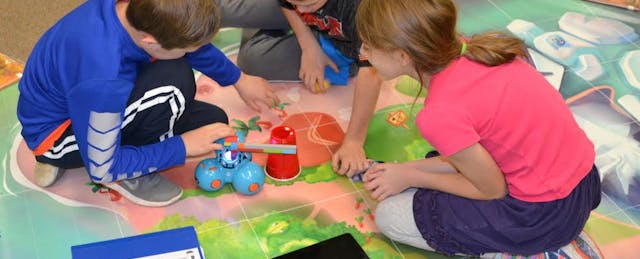I started my career as a librarian in the 1980’s. Back then, I learned to type catalog cards on an electric typewriter and created lessons around print resources and the Dewey Decimal system. I’ve come along way since then, moving from traditional library programming into the 21st century, with coding and robotics to match.
It all began when I read an article about the “Hour of Code” initiative, a program that asks every student school-wide to participate in one hour of coding activities. I knew nothing about the subject, but I thought it was important to try something new and see what happened. My hunch was right. During the event, my kids were challenged and totally engaged. I knew I was onto something.
Never too late (or early) to start
I started searching and found that during the previous year, West Virginia had more than 1000 coding jobs unfilled; the state’s universities had graduated just 120 computer science majors. Since my local area has taken an economic hit due to the loss of mining and industrial jobs, I know how important it is to let my students know about other available career paths. I don’t expect all of them to grow up and become software developers, but I do want them to learn that the devices they hold in their hands are not magic but created and programed by someone like them.
After the Hour of Code, I began to use the free code.org curriculum with my kindergarten through 5th grade students. But I didn’t want to leave out the pre-K kids either. After a search of the web, I found a site called mama.codes that gave very clear directions for young children on how to create interactive nursery rhymes and animations to simple songs using the free app Scratch Jr. I was skeptical when I tried it with the first class, but the little people did great and soon were confidently making their own creations.
For those interested in getting young students into coding, I’d also recommend codeclub.org. Their projects provide easy-to-follow step-by-step guides which help children learn Scratch, HTML & CSS and Python by making games, animations, and websites.
Robots in the library
Along with my new online curriculum, I also wanted to give the students real world opportunities to use their coding skills. I discovered a robot-building program for children which runs on Blockly, the same programming language students were already learning. Unfortunately, I didn’t have the funding to introduce robotics into my curriculum, so I turned to grant writing. My first purchase was a class set of Spheros, ball shaped robots. You can find many free apps to program these robots, including SPRK Lightening Lab. This app allows the teacher to assign lessons and provide sample codes for student use.Our first project was to learn how to code these balls to move in geometric shapes, roll them in paint and create original artwork.
Next we added Dash robots, which respond to sound, and have sensors to navigate around objects, dance, and sing. These are by far the most popular with the students. Each robot seems to have its own unique personality. They were so popular, the convinced me to start a robotics club. We met after school, once a week. Wonder Workshop offers a free competition so my club signed up, along with 5,300 teams from around the world. We figured we didn’t have a chance to place but continued to work through each of the challenges. In the end the kids, placed in the top 1 percent of the teams participating. It took them 123 tries to complete the final challenges but they never gave up and truly learned the meaning of teamwork. The whole school supported them and celebrated the victory.
Recently we have added a set of BeeBots. These are designed for use by young children. This colorful, easy-to-operate, and friendly little robot is a perfect tool for teaching sequencing, estimation, problem-solving, and is programmed by just pushing buttons. This is the perfect introduction to the higher levels of coding they will experience as they get older. In our first project the students designed a community, built small buildings, and set them up on a gridded mat. Then students programmed the little BeeBot to travel to different buildings in their community.
The value of evolving with the times
As the future of work changes in West Virginia and beyond, these programs become more and more important. Completing the coding and robotic challenges helps students build confidence in their ability to learn, especially in students who struggle with traditional academics and coding represents a new literacy skill that will be required for full participation in the digital world.
Changing my own conceptions of the library has also changed me. Through this process, I have learned that as a teacher, I don’t always have to have all the answers. It’s good to let the kids figure things out on their own sometimes. I am learning along with them and have seen my own skills grow and I have to admit it is a lot of fun to finally get the character on the screen or the robot do what you have programmed it to do.
Our curriculum is too new to evaluate long-term results, however the classroom teachers report seeing an improvement in their students’ logical thinking, problem solving, persistence, collaboration and communication skills. As for me, I know my students are engaged and are always are looking for new challenges. I can’t wait to see where this journey takes us next.


